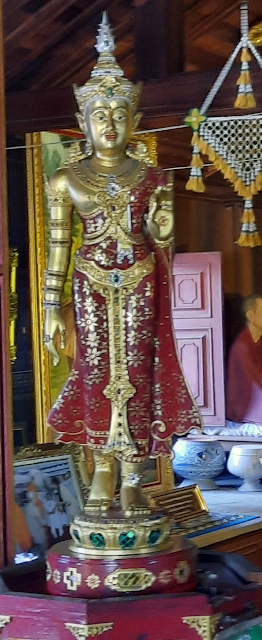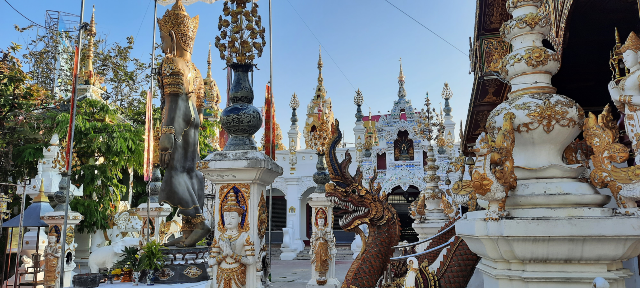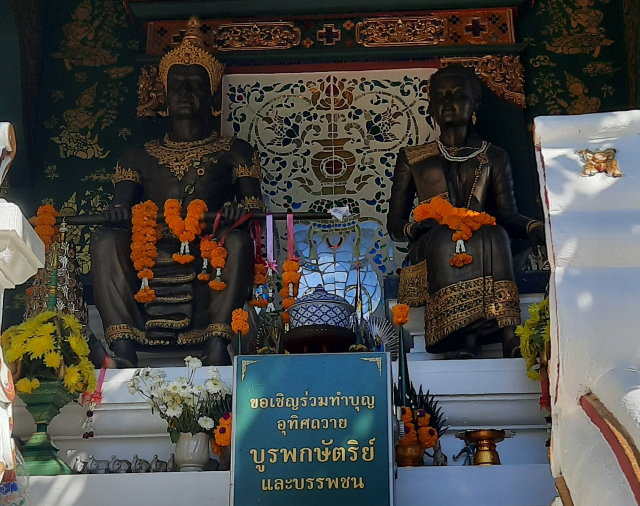On the main road of Banpha Prakan Road and crossing of Trairat Road is a beautiful white Wat with many crouching elephants on its temple wall. Like us, many get confused between Wat Ming Mueang and Wat Mung Mueang. For one, it's their close proximity to each other and secondly, their names also sound very similar.
History of temple:
- Wat Ming Mueang is a 700 year old temple and was built in 1262 during the reign of King Mengrai. Since, it was a royal temple, it was very important and prosperous.
- His queen Devi Usapayako, daughter of a Burmese ruler in Pha Ko city (Hong Sao Wadi), so the wat is also referred by that name.
- The queen ordered the first renovation of the temple and made royal visits to pay homage to main Buddha image enshrined in the temple's wooden vihara.
- The temple is also a memorial to King Mengrai's mother, Queen Chommuang, also known as Queen Thep Kamkayai who used to practice meditation in the vihara.
- King Mengrai used to make merit twice a year--- one on full moonlight of Visaka or the sixth month of lunar calendar, and the other on Loy Krathong day, which falls on the twelfth month of the lunar calendar. When visiting the wat, he circumambulated the pagoda twice in clockwise direction where his mother's ashes were kept.
- This temple was earlier called "Wat Chang Moop" which translates to "temple of crouching elephant". It is said that King Sarm Faggan of Chiang Mai had the Emerald Buddha, the one found at Wat Phra Kaew now, kept in his city. He ordered procession of elephants to greet the statue. The temple thus derived its name from the sitting posture of the royal elephants.
- Being one of the city gates of Chiang Rai called "Pathu Padang", the temple was a Tai Yai or Shan people's temple, as many Burmese Thais resided there. In 1877, these people helped in the renovation of temple with exquisite Burmese architecture.
- In 1970, the temple was officially enlisted as a Buddhist temple of Thailand and was named "Wat Ming Mueang", meaning "the auspicious temple of the city".
What to see in this temple:
Let me assure you that the temple provides ample opportunities for taking pictures. Every corner of the temple is worth a click.
- admire the entrance gate which is beautiful in red and gold
- the dwarapala or yaksha standing outside vihara or viharn
- viharn Mai lai Khum is the best example to appreciate Thai Yai (Myanmar) and Lanna style of architecture.
- admire the very high quality Buddha images inside viharn
- entry to ubosoth is not permitted but admire it from outside
- the sacred well on viharn's side
- climb up the stairs on side of the well, the roof has tuft grass and there are Buddha images on four sides, also a beautiful one which is seen from the road {Trairat Road}
- looking around the temple suggests that the temple must have been an important one, obviously with King Mengrai and his Queen coming it must not have been an ordinary one.
view of gate from temple side
The red and golden gate has a makar in center, hansa or hongsa on top of it. On the two sides are two naga. Going up further is Thao Jatulokbal with four faces and protecting it from all four directions. On top of it, is the crown with an umbrella or hti.wooden door of temple
view of gate from outside
It is impossible to pass under the gate and not notice how beautiful it is.
crouching elephants on both sides
view of temple guardian or yaksha
Observe the guardian's feet, you would see that one of his foot is in front, showing that he is ready to take action to protect the temple.
Hansa or hongsa decorate the roof of viharn as well as the ubosoth.Viharn Mai Lai Khum:
 red and gold naga at entrance
red and gold naga at entrance Both viharn with red roof and ubosoth with green roof have hongsa on their roofs
Both viharn with red roof and ubosoth with green roof have hongsa on their roofs
The viharn is entirely wooden and is a mixture of Thai-Yai (Myanmar) and Lanna style. It is beautifully decorated and is one of the best Lanna style temple in Chiang Rai.
 red and gold naga at entrance
red and gold naga at entrance Both viharn with red roof and ubosoth with green roof have hongsa on their roofs
Both viharn with red roof and ubosoth with green roof have hongsa on their roofsnaga at entrance
what a beautiful temple
an image of Buddha in a blessing posture
Luang Phor Phra Sri Ming Muang is an ancient stucco Buddha image gilded over with lacquer surface. It is said to be more than 400 years old and is 80 inches in width.The image is in Chiang Saen Singh 1 style in which the body is plump, hair is curled, with a hair bun in lotus shape. It is studded with semi precious gemstones.
roof of ubosoth and vihar are also beautifully decorated
Satellite and other temples:
On the side of ubosot is this small place, nothing is written there so I am not sure what it is
elephant and hongsa on pillar by the side of viharnThis is a fairly new construction, a part of it was still not ready when we went in December 2021.
inside the temple is an image of Buddha under Mucalinda
Every where you look, something or the other fascinates you
Portrait of King Mengrai
Khochasi
Khochasi, which has a lion's body but head of an elephant
front view of ubosoth
the ubosoth usually remains closed
side of building
hongsa on the roof of viharn and ubosot
The Ming Muang Stupa:
It enshrines relics of king Mengrai's mother, Chao Nang Talamae Si. Designed with a mix of Myanmar and Lanna architecture. The topmost structure stands on a bulbous base. The chedi has an umbrella in Myanmar style on top. It is said to be the oldest structure in temple complex.
The stupa houses relics of King Mengrai's mother, Chao Nang Talamae Sri
front of chedi
image of Buddha and on the sides crouching elephants
Bo Nam Chang Mub:
It is said to be an ancient sacred well. It is said to bring good fortune if one drinks the water and washes their faces before leaving.
It faces east and had a Kong-style roof which was arched. When we went, they were renovating the place.
the roof of well was being constructed
well under repairs/construction
water in the well
Apart from vihar, ubosot, chedi, there are many temples or structures.
A white building which was still under construction when we visited
elephant and hongsa on pillar by the side of viharnThis is a fairly new construction, a part of it was still not ready when we went in December 2021.
inside the temple is an image of Buddha under Mucalinda
Temples on the terrace:
There is a terrace from the side of well. Do not miss the chance of going up too see many images of Buddha.
view of temple from the terrace
up the stairs
Phaya naga, which is a combination of naga and Garuda
stunning elephant
absolutely breathtaking phaya naga as seen from the roadimage inside the niche we see from outside
bell on terrace
terrace with beautiful pillars and temples
in the center is this beautiful temple
four corners of terrace:
on the four corners of terrace are the following images
reclining mudra
rear view of temple
image in a temple
Buddha footprints
I can only say that the wat is very beautiful and I needed more time than I had allocated for myself. Looking back, I remember things which I missed.
Timings: 8:00 A.M. to 4:30 P.M.
Entrance fee: free














































































No comments:
Post a Comment
Thanks for visiting my blog. Your feedback is always appreciated.